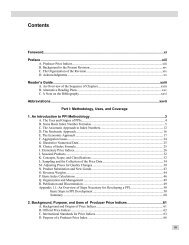Disclosures to Promote Transparency and Market - IFSB
Disclosures to Promote Transparency and Market - IFSB
Disclosures to Promote Transparency and Market - IFSB
You also want an ePaper? Increase the reach of your titles
YUMPU automatically turns print PDFs into web optimized ePapers that Google loves.
Quantitative<br />
<strong>Disclosures</strong><br />
2. The amount of Tier 1 capital, with separate disclosure of:<br />
• issued <strong>and</strong> paid-up share capital of IIFS, <strong>and</strong> any changes<br />
since the last reporting financial year;<br />
• reserves; 16<br />
• minority interests in the equity of subsidiaries;<br />
• any capital- <strong>and</strong> equity-related capital instruments that are<br />
eligible for inclusion in Tier 1 capital;<br />
• surplus capital from insurance companies; 17 <strong>and</strong><br />
• other reserves. 18<br />
• Shareholdings equal <strong>to</strong> or exceeding 5% of the <strong>to</strong>tal paid-up<br />
capital.<br />
3. The <strong>to</strong>tal amount of Tier 2 <strong>and</strong> Tier 3 capital.<br />
4. Total eligible capital.<br />
5. The amount of unrestricted IAH funds.<br />
6. Profit equalisation reserve (PER) (shareholders’ <strong>and</strong> IAH<br />
components) 19 <strong>and</strong> investment risk reserve (IRR). 20<br />
4. Capital Adequacy<br />
31. Capital adequacy determination for IIFS differs from that for conventional<br />
financial institutions in that: (a) its financing arrangements are either asset-based or<br />
profit- <strong>and</strong> loss-sharing (Mushārakah), or profit-sharing <strong>and</strong> loss-bearing (Muḍārabah);<br />
<strong>and</strong> (b) much of the funding is raised through unrestricted investment accounts that are,<br />
in principle, a form of equity. As such, the underlying assets involved under the Sharī`ah -<br />
compliant financing contracts may be exposed <strong>to</strong> market (price) risk, as well as <strong>to</strong> credit<br />
risk in respect of the amount due from the counterparty. Risk-weighted assets financed<br />
by PSIA shall, in principle, be excluded in the calculation of the denomina<strong>to</strong>r of the capital<br />
ratio, insofar as the commercial risk of these assets does not affect the IIFS’s owner’s<br />
capital. In practice, however, a proportion of these RWA, or even the full amount, may be<br />
16 Reserves included in Tier 1 capital are disclosed reserves created or increased by appropriations of<br />
retained earnings, or other surplus (such as general reserves <strong>and</strong> legal reserves, freely <strong>and</strong> immediately<br />
available <strong>to</strong> meet claims against the bank). General loan loss reserves, asset revaluation reserves <strong>and</strong> other<br />
undisclosed reserves (all within legal <strong>and</strong> regula<strong>to</strong>ry limits) are part of Tier 2 capital.<br />
17<br />
The capital invested in a majority-owned or controlled insurance entity may exceed the amount of<br />
regula<strong>to</strong>ry capital required for such an entity (surplus capital). Supervisors may permit the recognition of<br />
such surplus capital in calculating a bank’s capital adequacy, under limited circumstances. Banks<br />
recognising surplus capital in insurance subsidiaries will publicly disclose the amount of such surplus capital<br />
recognised in their capital. Where a bank does not have a full ownership interest in an insurance entity (for<br />
example, 50% or more but less than 100% interest), surplus capital recognised should be proportionate <strong>to</strong><br />
the percentage of interest held. Surplus capital in significant minority-owned insurance entities will not be<br />
recognised, as the bank would not be in a position <strong>to</strong> direct the transfer of the capital in an entity that it does<br />
not control (Basel II, 2005).<br />
18 Reserves available <strong>to</strong> the IIFS from the surplus capital of non-banking subsidiaries that are not<br />
consolidated. Such a reserve is often used <strong>to</strong> indicate financial strength.<br />
19 PER comprises amounts appropriated out of the gross income from the Muḍārabah <strong>to</strong> be available for<br />
smoothing returns paid <strong>to</strong> the IAH <strong>and</strong> the shareholders, <strong>and</strong> consists of a PSIA portion <strong>and</strong> a shareholder’s<br />
portion. See <strong>IFSB</strong>, Capital Adequacy St<strong>and</strong>ard for Institutions (other than Insurance Institutions) Offering<br />
only Islamic Financial Services, December 2005.<br />
20 IRR comprises amounts appropriated out of the income of IAH, after deduction of the Muḍārib share of<br />
income, <strong>to</strong> meet any future losses on the investments financed by the PSIA. See <strong>IFSB</strong>, Capital Adequacy<br />
St<strong>and</strong>ard for Institutions (other than Insurance Institutions) Offering only Islamic Financial Services,<br />
December 2005.<br />
8
















